Phenotypic plasticity is the ability of an organism to adjust morphology and/or physiology in response to environmental variation. Hydrocotyle bonariensis is a perennial herb found in both coastal sand dune and inland habitats of coastal Georgia. The soil types of these two habitats differ in both soil characteristics and soil chemistry. The purpose of this study was to explore potential phenotypic plasticity in H. bonariensis in response to two different soil types by comparing leaf and petiole morphology and stomata density and length between individuals grown in soil from a sand dune habitat and soil from an inland coastal habitat. Results showed significantly greater leaf area, petiole fresh weight, petiole thickness, and petiole length in individuals grown in inland soil compared to sand dune soil. Furthermore, the density of stomata on bottom leaf surfaces was significantly greater in plants grown in inland soil, and the length of stomata on the top and bottom leaf surfaces was significantly greater in plants grown in sand dune soil. These results suggest that the differences in soil texture, and subsequent differences in waterholding capacity and nutrient availability, likely led to the observed differences in leaf and petiole morphology, while differences in stomata density and length may represent a phenotypic plastic response in this species to soil type. The ability of H. bonariensis to respond plastically to changes in environmental conditions, such as variations in soil type, likely plays an important role in its ability to successfully thrive in multiple habitats in Georgia.
How to translate text using browser tools
1 June 2018
Examination of phenotypic plasticity in Hydrocotyle bonariensis in response to two soil types
Savannah D. Chiarello,
Heather M. Joesting
ACCESS THE FULL ARTICLE





